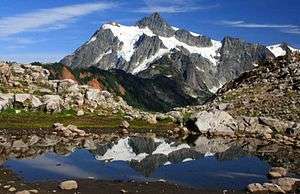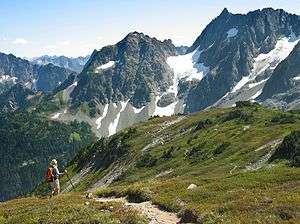North Cascades
Regions
The North Cascades can be divided into two distinct subregions due to the Cascade Mountains which run north to south across the middle of the region - Northwest Cascades and North Central Cascades
Cities
- 🌍 Anacortes - gateway to the San Juan Islands
- 🌍 Edison - a small artsy town, near Burlington
- 🌍 Ellensburg - county seat of Kittias County and home to Central Washington University
- 🌍 La Conner - home of the Tulip Festival
- 🌍 Leavenworth - Bavarian themed town
- 🌍 Mount Vernon - county seat of Skagit County
- 🌍 Bellingham - last US city before Canada on I-5, and capital of Whatcom County
- 🌍 Wenatchee - county seat of Chelan County
Other destinations

- Colville Indian Reservation
- 🌍 Grand Coulee Dam
- Lake Chelan National Recreation Area - Ride the Lady of the Lake to the historic and unique town of Stehekin in the heart of Lake Chelan National Recreation Area
- 🌍 Mount Baker ski resort, on a mountain of the same name
- Nooksack Falls, on Highway 542, 7 miles east of the Glacier Ranger Station
- 🌍 North Cascades National Park - Jagged peaks, deep valleys, cascading waterfalls and over 300 glaciers adorn the North Cascades National Park
- Ross Lake National Recreation Area - Visit the Ross Lake National Recreation Area and stretch your legs at one of the stops along the scenic North Cascades Highway
- Summit at Snoqualmie - ski resort at Snoqualmie Pass
Understand
The Cascades are a mountain range that stretches some 700 miles (1100 km) from British Columbia through central Washington into Oregon. By causing moist Pacific air to drop rain and dry out as it blows into the continent, the Cascades divide Washington state into a wet west and an arid east. The Cascades are tall -- several are above 10,000' (3000m) high, including Mount Baker in this region. Because their valleys are low and the mountains quite steep, many mountains in the Cascades are visually quite striking.
To the west from the Cascades to the coast are lowlands. Interstate 5 (I-5) runs north from Seattle to Vancouver, British Columbia. In Snohomish county, cities like Everett and Snohomish are in the outer reaches of Seattle's influence. The Skagit Valley is fertile farmland, overflowing with tulips in the spring. Just off I-5, Anacortes is the gateway to the San Juan Islands. Further north, Bellingham is the last US city before the Canadian border.
The North Cascades region is made up of Chelan, Kittitas, Okanogan, Skagit, and Whatcom counties. The term "North Cascades" sometimes means the mountain chain as far south as Mount Rainier. The Cascades continue south in the Southwest Washington region, then into Oregon and northern California.
Get in
By train
Amtrak's Cascade and Empire Builder service serve different parts of this region. In the Northwest Cascades the Amtrak Cascades stops in Mount Vernon and Bellingham: the service heads north to Vancouver and south to Seattle. In the North Central Cascades region the Empire Builder stops daily at Leavenworth and Wenatchee on its way west to Seattle or east to Chicago.
By car
From British Columbia
Interstate 5 and the Peace Arch crossing is the main land port-of-entry to this region of Washington from Canada. However this is only one of five land crossing points between the Lower Mainland region of BC and the Northwest Cascades region of Washington. See the Get in — by car section of Northwest Cascades region article for details.
Get around
See
Itineraries
The North Cascade Loop is a very scenic drive that loops around this area through pristine mountains, grand rivers, crystalline lakes and scenic islands. If you can't do the loop, at least go as far as Mazama (eastbound) or the visitor center near Newhalem (westbound) on State Hwy 20. Note the most spectacular parts of the drive are not where the highway is sandwiched between the two halves of the national park, but further east in the Okanogan National Forest. The highest point is Washington Pass at 5,477 feet. As the park has virtually no roads, non-hikers should stay on the main highway unless clearly marked signs are visible (such as the visitor center which is about a mile to the south).
Do
Hiking, fishing, white water rafting, skiing, snowshoeing, boating
Eat
Drink
Coffee
Coffee is hugely popular all across the Pacific Northwest including North Cascades. Look for small road side espresso stands even in small towns.
Beer
Like the rest of Washington State, microbreweries and beer in general is hugely popular, and the area has many to offer for beer enthusiasts. Some brews can only be found in local stores or bars (some notable brewers don't even bottle their product). Ask your servers for local beer recommendations and search out regional microbrews in stores.
Wine
Although the North Cascades is not known as wine country, many Washington State wines are still and plentiful in restaurants and stores.
Stay safe
Fuel
After you pass Marblemount on the North Cascades Highway (going eastbound), there is no gas for 70 miles until Mazama. There is also no cell phone coverage (no matter which carrier) from Ross Lake to Mazama. If you need assistance, you'll have to flag down someone with a two-way radio, or obtain a lift.
Avalanches
In the Cascade Mountains (which divide the state into halves) there can be significant snow accumulations during the late fall and winter months. This poses a danger for avalanches whenever these areas experience warm up periods, regardless of how brief they may be. Washington Pass is at an elevation of 5477 ft. (1669 m), and can have snowfall on any day of the year. and mountain passes are sometimes closed for avalanche control and may effect travel plans. Check the Washington State Department of Transportation website for information regarding Avalanche control.
If going into the mountains during winter and early spring months, refer to the Northwest Weather and Avalanche Center website for information regarding the current avalanche dangers throughout the Cascade region of the state.
